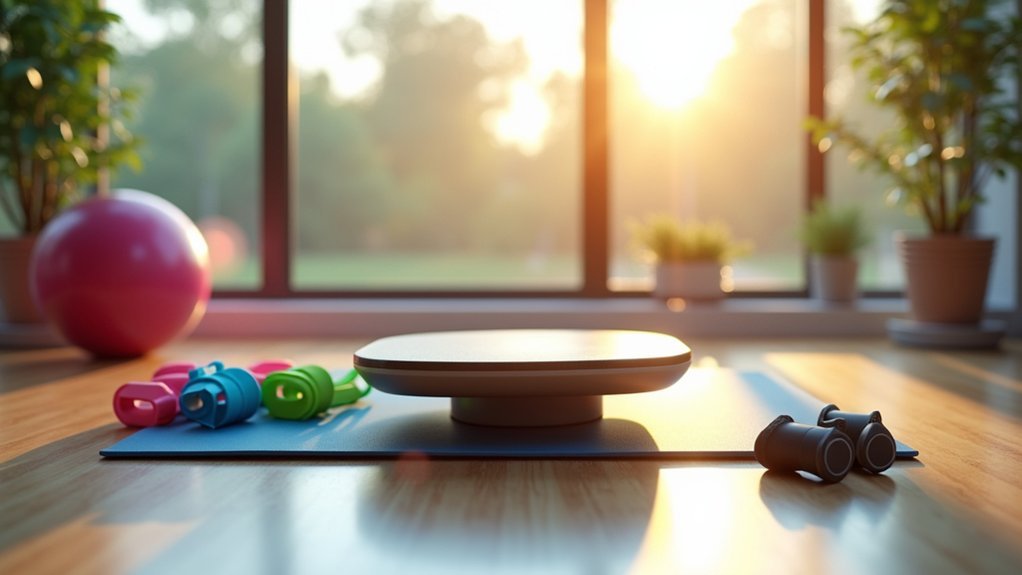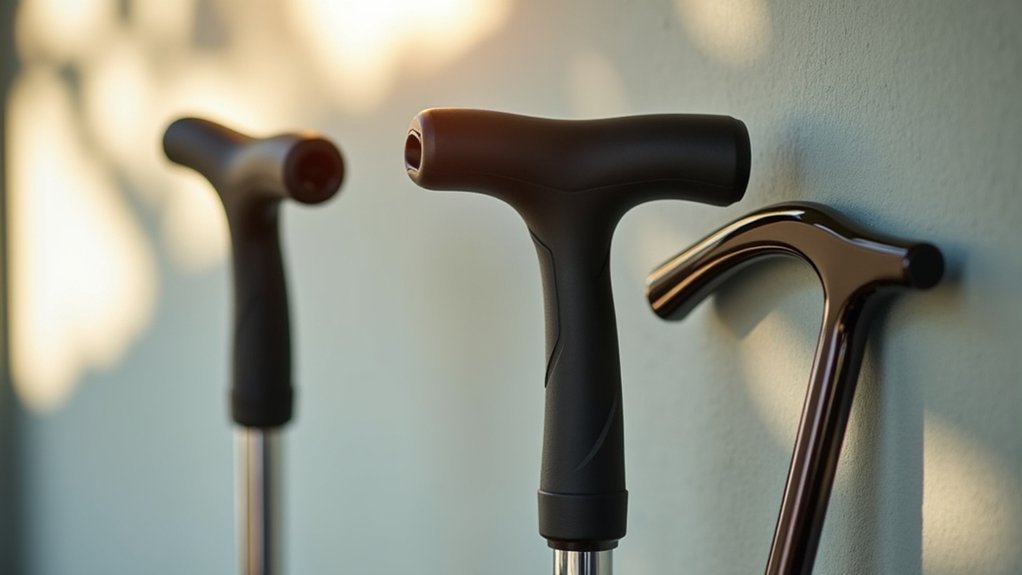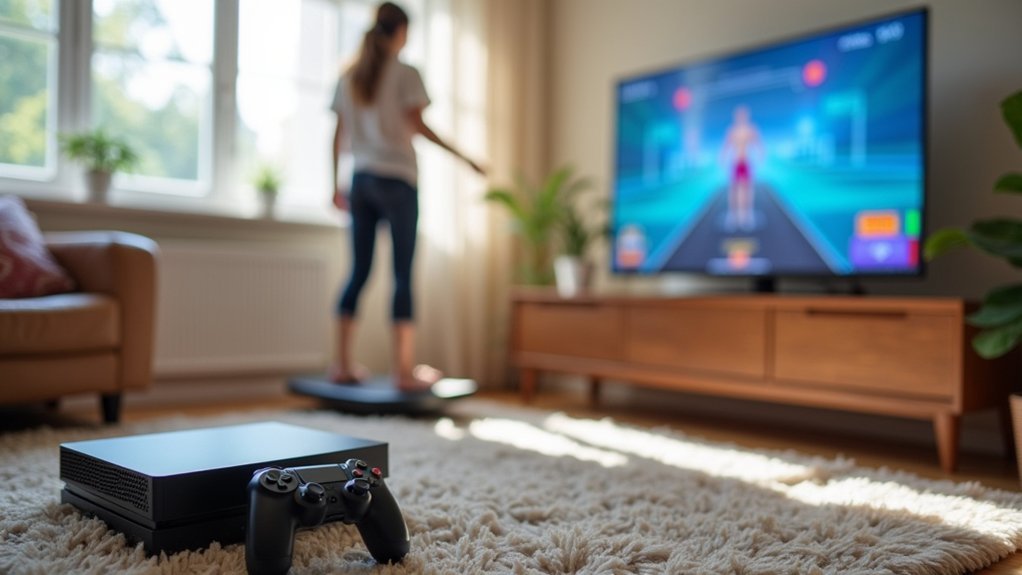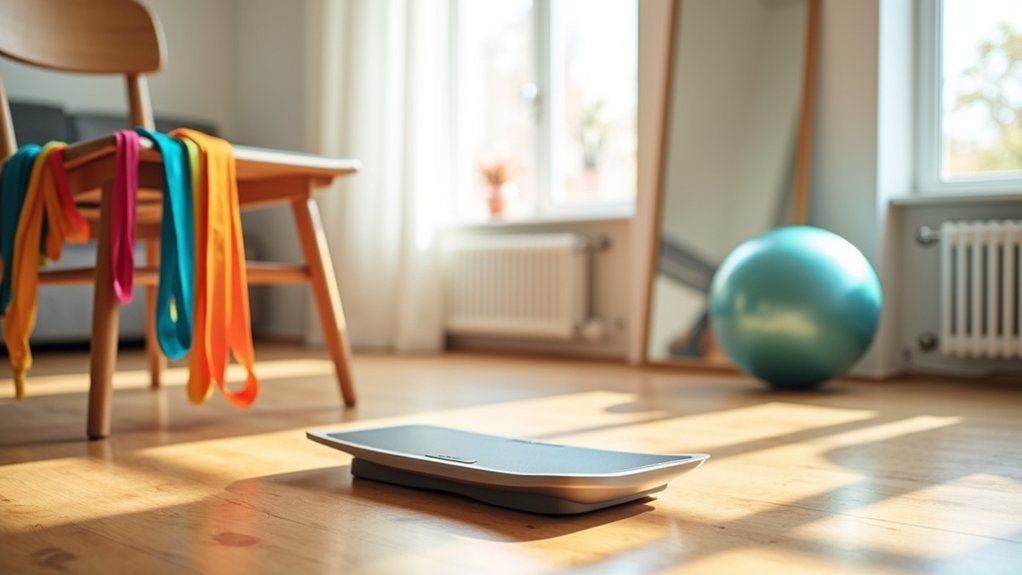For better balance with MS, you’ll benefit from balance boards and wobble cushions to strengthen your core, FES devices to manage foot drop, and weighted walking poles for stability. Resistance bands can build lower body strength while seated balance ball chairs improve posture during daily activities. AFOs and supportive footwear provide essential support, and mini trampolines with support bars offer controlled exercise. These tools work best when integrated into a thorough treatment approach. Discover how each option can transform your stability and confidence.
Top MS Therapy Tools for Better Balance

Balance challenges represent one of the most common hurdles for people living with Multiple Sclerosis.
Fortunately, several effective therapy tools can help you maintain stability and independence.
Mobility devices like canes, walkers, and AFOs provide vital support during daily activities, greatly reducing fall risk.
Your stability is your freedom. Mobility devices don’t restrict independence—they expand your world by reducing fall risks.
For foot drop symptoms, Functional Electrical Stimulation (FES) can stimulate muscles to improve your gait pattern.
Regular balance exercises through physiotherapy are essential—activities like Tai Chi and yoga have proven particularly effective for people with multiple sclerosis (MS).
Simple strengthening routines such as seated ankle lifts and weight shifting in a staggered stance can remarkably improve balance when practiced consistently.
Don’t overlook the value of home adaptations recommended by occupational therapists—these modifications can transform your living space into a safer environment that supports your mobility goals.
Balance Boards and Wobble Cushions: Core Stability Enhancers
Balance boards and wobble cushions provide you with dynamic training that challenges and improves your stability as you cope with MS symptoms.
You’ll strengthen critical stabilizing muscles throughout your core, hips, and legs when you incorporate these tools into your regular routine.
These versatile devices offer progressive difficulty levels that can match your current abilities and grow with you as your balance improves.
Dynamic Balance Training
When stability becomes challenging due to MS symptoms, dynamic balance training tools offer a practical approach to rebuilding core strength and coordination.
Balance boards and wobble cushions create unstable surfaces that engage your core muscles and improve proprioception—your body’s ability to sense its position in space.
You’ll find that just 10-15 minutes of daily practice can greatly enhance your postural control and reduce fall risk.
These tools work by challenging your balance systems, forcing your body to make constant micro-adjustments that strengthen vital stability muscles.
Start with exercises matched to your current abilities, then gradually increase difficulty as you progress.
The beauty of dynamic balance training is its effectiveness in building core stability while simultaneously improving confidence in everyday movements—benefits that extend well beyond your exercise sessions.
Strengthens Stabilizing Muscles
Core stability emerges as the hidden foundation of better balance for MS patients who regularly use balance boards and wobble cushions. These versatile tools force your body to engage stabilizing muscles that often remain dormant during regular exercises.
When you stand on a balance board or sit on a wobble cushion, you’re actively improving your proprioception—your body’s awareness of its position in space. This translates to better postural control and fewer falls in your daily activities.
| Exercise Tool | Stabilizing Muscles Targeted | Benefit for MS | Difficulty Level | Position Options |
|---|---|---|---|---|
| Balance Board | Core, ankles, knees | Improves coordination | Moderate to high | Standing |
| Wobble Cushion | Lower back, abs | Enhances posture | Low to moderate | Sitting or standing |
You’ll notice improved confidence in movement with consistent practice, making everyday tasks safer and more manageable.
Progressive Difficulty Levels
One significant advantage of balance boards and wobble cushions lies in their adaptable challenge levels, allowing you to progress at your own pace as your stability improves.
These mobility devices are perfect for addressing balance issues that often accompany MS.
- Start simple – Begin on a wobble cushion while seated or holding onto a stable support
- Gradually increase time – Add 30 seconds to your balance exercises to improve your stability
- Reduce support – Shift from two-handed to one-handed to no support as you improve your balance
- Add movement challenges – Incorporate arm movements or head turns to further challenge your core stability
As you master each level, you’ll develop stronger core muscles and greater confidence in your everyday movements.
Functional Electrical Stimulation (FES) Devices for Foot Drop
Innovative FES devices offer promising support for MS patients struggling with foot drop. These portable systems deliver targeted electrical signals to stimulate weakened muscles in your foot and ankle, helping you lift your foot properly while walking.
For many users, functional electrical stimulation can improve walking speed by approximately 25%, directly addressing the muscle weakness that contributes to balance issues.
Your healthcare provider will help determine if an FES device suits your needs through thorough assessment. The system typically consists of a small stimulator worn on your leg connected to electrodes placed over specific muscles.
For best results, you’ll likely use your FES device alongside physiotherapy and other rehabilitation approaches. This integrated treatment strategy maximizes improvements in your gait, balance, and overall mobility.
Weighted Walking Poles and Specialized Canes

You’ll find revolutionary stability through weighted walking poles and specialized canes that incorporate advanced balance technology.
These mobility aids distribute your body weight more evenly across multiple points of contact, reducing leg strain and enhancing your gait pattern.
The ergonomic designs, with features like shock absorption and anti-slip tips, can transform your daily mobility experience, giving you greater confidence and independence as you manage MS symptoms.
Stability Through Technology
When balance becomes unpredictable due to MS, technological innovations in mobility aids can provide critical support for daily activities.
Weighted walking poles and specialized canes incorporate advanced features that enhance your stability while maintaining independence.
- Weighted walking poles distribute your weight more evenly, reducing fall risk and improving your confidence during ambulation.
- Ergonomic grip canes with adjustable heights offer customizable support for various environments you’ll navigate daily.
- Shock absorption technology in advanced canes minimizes joint strain, providing a smoother walking experience.
- Specialized stability aids can actually improve your walking speed and balance metrics, contributing to better overall physical function.
These technological advances in mobility support can help you maintain activities with greater confidence and reduced fear of falling.
Weight Distribution Benefits
Proper weight distribution stands at the core of mobility management for MS patients struggling with balance issues.
Weighted walking poles can transform your walking experience by enhancing stability and allowing you to distribute weight more evenly across your body, greatly reducing fall risks.
These specialized tools, along with ergonomically designed canes, help you maintain better posture and alignment while walking.
You’ll notice that they promote a more natural gait pattern by encouraging proper weight shifting, which can alleviate muscle tightness and spasticity discomfort.
Research shows these aids reduce the energy you expend while walking, helping you conserve strength for longer distances.
Resistance Bands for Lower Body Strengthening
Strengthening your lower body remains vital for maintaining balance when living with MS, and resistance bands offer an ideal solution for this purpose.
These versatile tools can greatly improve leg strength while being gentle on your joints, making them perfect for your exercise routine.
- Choose bands with appropriate resistance levels – start light and progress as your strength improves
- Perform seated leg extensions to target quadriceps, essential muscles for stability when standing and walking
- Include lateral leg lifts with bands to strengthen hip stabilizers that prevent sideways falls
- Practice consistently to build confidence in your movements as your balance improves
With regular use, you’ll notice enhanced muscle stability and coordination, making everyday activities easier and reducing fall risks.
Balance-Focused Video Game Systems and Apps

Technology offers exciting alternatives to traditional balance exercises through interactive gaming systems designed specifically for rehabilitation. The Nintendo Wii and Xbox Kinect use motion-sensing technology that lets you improve balance and coordination while having fun.
Apps like “Balance Trainer” and “Fit Brains Trainer” provide targeted exercises in game format, making rehabilitation more enjoyable. You’ll benefit from real-time feedback and progress tracking, helping you stay motivated throughout your journey.
Research confirms that using these video games can greatly improve your postural stability and reduce fall risks. The gamified experience encourages consistent practice without the monotony of conventional exercises, increasing your likelihood of sticking with the program.
Game-based balance exercises significantly improve stability while keeping users engaged and committed to their rehabilitation journey.
These interactive tools transform necessary therapy into an engaging activity you’ll look forward to.
Seated Balance Ball Chairs for Daily Use
Your seated balance ball chair offers powerful core stability benefits while gently correcting poor posture throughout your day.
You’ll engage abdominal and back muscles continuously, strengthening the essential support system that maintains your overall balance with MS.
Core Stability Benefits
Balance sits at the center of managing MS symptoms, and seated balance ball chairs offer a practical way to enhance this critical skill.
By engaging your core muscles during regular sitting, you’ll strengthen your foundation for better stability throughout daily activities.
- Improved proprioception – You’ll develop greater awareness of your body’s position, helping reduce fall risks common with MS.
- Enhanced core stability – Regular use strengthens abdominal and back muscles that support proper posture.
- Increased functional mobility – Core strength gained transfers to everyday movements, making daily tasks easier to perform.
- Reduced fatigue – Active sitting prevents the discomfort associated with prolonged inactivity.
This simple seating adjustment can lead to significant improvements in your balance and coordination over time, giving you more confidence in your movements.
Posture Correction Features
While traditional chairs encourage slouching, seated balance ball chairs incorporate specific design elements that naturally guide your body into proper alignment.
These innovative chairs activate your core muscles continuously, promoting active sitting that helps correct postural issues common in MS.
You’ll notice the chair’s design challenges your body to maintain stability throughout the day, which strengthens essential muscles needed for balance and coordination.
The gentle movement required to stay centered on the ball naturally aligns your spine and reduces muscle tension that contributes to discomfort.
Orthotic Devices and Supportive Footwear
The right combination of orthotic devices and supportive footwear can dramatically improve stability for those living with MS.
Ankle-foot orthoses (AFOs) effectively manage foot drop by lifting your foot during walking, while functional electrical stimulation (FES) units offer a non-invasive alternative that helps with muscle contraction and mobility.
- Choose shoes with sturdy construction and rubber soles for maximum traction
- Ensure proper fit with ½ to 1-inch space in front of your big toe
- Keep heel height under 2 inches to maintain better balance
- Consult specialists like podiatrists and orthotists for personalized recommendations
Don’t underestimate how the right footwear and orthotic devices can transform your mobility experience, reducing fall risks and improving your confidence when maneuvering daily activities.
Mini Trampolines With Support Bars
Three key features make mini trampolines with support bars an invaluable tool for MS balance training.
First, they provide a stable yet responsive surface that challenges your equilibrium in a controlled environment, reducing fall risks while improving coordination.
Second, the supportive bars offer security as you bounce, building confidence during exercises that target core and lower body strength.
Third, these mini trampolines deliver impressive results through convenient home use. You’ll notice improvements in muscle tone and proprioception with consistent practice, directly enhancing your daily mobility.
The gentle bouncing motion engages multiple muscle groups simultaneously, making your balance exercises more effective than stationary training alone.
For maximum benefit, incorporate your mini trampoline into a daily routine with exercises tailored to your specific MS symptoms and abilities.
Tai Chi and Yoga Equipment Adaptations
Modified equipment for Tai Chi and yoga practice offers essential adaptations that transform these ancient disciplines into accessible MS therapy tools. Both practices emphasize mindful movement and breathing techniques that reduce stress while improving your stability and confidence.
- Chair supports – Use sturdy chairs during yoga poses or Tai Chi movements to maintain balance while building strength and flexibility.
- Wall assistance – Perform exercises near walls for added stability during standing balance exercises.
- Supportive props – Incorporate blocks, straps, and bolsters to achieve proper alignment in yoga poses.
- Adapted movements – Customize Tai Chi and yoga exercises to your ability level, focusing on regular practice to improve lower body strength and proprioception.
These adaptations allow you to safely experience the benefits of both practices, enhancing mobility and reducing fall risk.
Frequently Asked Questions
How to Improve Balance in Multiple Sclerosis?
You can improve your balance with MS by practicing seated ankle lifts, stretching daily, using mobility aids when needed, engaging in targeted physiotherapy, and regularly testing your progress with single-leg stands.
What Is the Best Therapy for Balance?
The best therapy for balance combines physiotherapy with targeted exercises, alternative practices like yoga or Tai Chi, and regular home exercises. You’ll also benefit from mobility aids and treatments like FES when needed.
What Are the Assistive Devices for Multiple Sclerosis Patients?
You’ll benefit from various assistive devices for MS, including mobility aids (canes, walkers, crutches), AFOs or FES for foot drop, wheelchairs, scooters, grab bars, reachers, and properly fitted supportive footwear.
What Is the Best Exercise Equipment for Multiple Sclerosis Patients?
For MS patients, you’ll benefit most from resistance bands, stability balls, balance boards, and exercise mats. These tools strengthen muscles, improve balance, and enhance mobility while allowing you to exercise safely at home.
In Summary
When you’re managing MS, incorporating these balance tools into your daily routine makes a significant difference. You’ll find your stability improving as you build core strength and confidence. Remember, consistency with these therapies yields the best results. Work with your healthcare team to select the right tools for your specific needs, and don’t hesitate to adjust your approach as your condition changes.





Leave a Reply